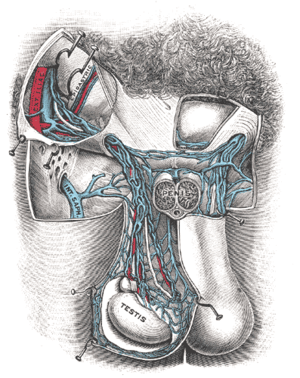Pampiniform plexus
The pampiniform plexus (from Latin pampinus, a tendril, + forma, form) is a venous plexus – a network of many small veins found in the human male spermatic cord, and the suspensory ligament of the ovary. In the male, it is formed by the union of multiple testicular veins from the back of the testis and tributaries from the epididymis.
| Pampiniform plexus | |
|---|---|
 Spermatic veins. | |
| Details | |
| Drains from | testicle, epididymis |
| Drains to | testicular vein |
| Identifiers | |
| Latin | plexus venosus pampiniformis, plexus pampiniformis |
| TA | A12.3.09.015 |
| FMA | 19607 |
| Anatomical terminology | |
In the male
The veins of the plexus ascend along the spermatic cord in front of the vas deferens. Below the superficial inguinal ring they unite to form three or four veins, which pass along the inguinal canal, and, entering the abdomen through the deep inguinal ring, coalesce to form two veins. These again unite to form a single vein, the testicular vein, which opens on the right side into the inferior vena cava, at an acute angle, and on the left side into the left renal vein, at a right angle. The pampiniform plexus forms the chief mass of the cord.
In addition to its function in venous return from the testes, the pampiniform plexus also plays a role in the temperature regulation of the testes. It acts as a countercurrent heat exchanger, cooling blood in adjacent arteries. An abnormal enlargement of the pampiniform plexus is a medical condition called varicocele.
In the female
In females, the pampiniform plexus drains the ovaries. The right ovary drains from the plexus to the ovarian vein and then to the inferior vena cava. However, the left ovary drains from the plexus to the left ovarian vein, and from there drains to the left renal vein before emptying into the inferior vena cava.[1]
See also
- Rete mirabile, vascular countercurrent heat- and mass-exchanging structures found in many vertebrate organs
References
This article incorporates text in the public domain from page 1240 of the 20th edition of Gray's Anatomy (1918)
- First Aid for the USMLE Step 1, 2013.
External links
- Anatomy photo:36:st-0701 at the SUNY Downstate Medical Center - "Inguinal Region, Scrotum and Testes: Veins"
- Histology image: 17304ooa – Histology Learning System at Boston University - "Male Reproductive System: spermatic cord, pampiniform plexus"
- Histology image: 81_05 at the University of Oklahoma Health Sciences Center - "Spermatic cord"
- Cross section image: pembody/body18b—Plastination Laboratory at the Medical University of Vienna
- inguinalregion at The Anatomy Lesson by Wesley Norman (Georgetown University) (spermaticcord)
- Diagram at Rutgers